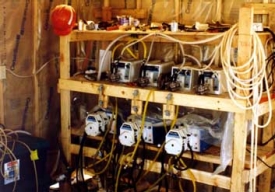Our group has made a series of advances in surfactant-enhanced aquifer remediation (SEAR) over the past fifteen years, often resulting from the coupling of laboratory and field studies with economic considerations. An early advance looked at surfactant-enhanced solubilization versus mobilization and developed supersolubilization and gradient systems that realized higher removal efficiencies, and thus improved system economics, while avoiding vertical migration concerns for oil phases denser than water. System economics also motivated development / adaptation of separation processes for surfactant recovery and reuse, which is especially important for multiple pore volume (> 3 to 5 pore volumes) surfactant flushes. More recently, low surfactant concentration systems (< 1 wt%) have been developed to reduce surfactant purchase costs and the operating expense of recovering / reusing the surfactant. The most recent development to be discussed is integration of SEAR with a polishing technology such as in situ chemical oxidation (ISCO). This integrated approach was motivated by the field observation that even though significant contaminant mass removed (> 85 to 95%) can reduce ground water concentrations by one to two orders of magnitude, the post-remedial concentrations can still exceed site closure goals. By combining SEAR with an aggressive polishing step such as ISCO, it is possible to further reduce ground water concentrations toward closure goals in a timely manner.
Surfactant-Enhanced Environmental Applications

IASR members have developed several new membrane separation methods, involving the addition of surfactants and other water-soluble colloids to contaminated aqueous streams. These colloid-enhanced ultrafiltration processes can be used to remove both organic and metal impurities from water. In micellar-enhanced ultrafiltration (MEUF), a surfactant is added to the water; it spontaneously forms aggregates called micelles, containing approximately 100 surfactant molecules. These species solubilize or bind the pollutant so effectively that most of the impurities associate with the micelles. When the solution is passed through an ultrafilter having pore sizes small enough to block passage of the micelles, the resulting permeate contains greatly reduced concentrations of the contaminants. The solution rejected by the membrane (the retentate) contains the organics and metals at high concentrations, facilitating the recovery and disposal of these substances. In variations of the MEUF method, other colloids (including polyelectrolytes and mixtures of water-soluble polymers and surfactants) are used to remove both ionic and molecular pollutants. By using ligands that are selective for particular ions, it is possible to remove individual dangerously toxic substances, while permitting innocuous species to pass freely into the permeate. A sample project was the estimate of the number of MEUF stages to remove 99 % of trichloroethylene from polluted groundwater. Recently, the use of ultrafiltration with colloids has been applied to removal of arsenic to less than 10 ppb in drinking water applications.


Development of effective methods for deinking of plastics offers tremendous economic and environmental benefits to manufacturers and consumers alike. IASR research staff have been developing a fundamental understanding of the deinking of plastic films. IASR researchers have examined a number of surfactants for deinking plastics and analyzed properties of the re-extruded material to assess its value for reuse. The most significant factor inhibiting extensive reuse of all plastics is the existence of printing inks in plastic after re-extrusion. Deinking of plastic packaging is fundamentally a laundering process: detachment of inks from the plastic packaging film by a chemical mechanism, and separation of the detached soil from the substrate and dispersion of soil in a washing bath by mechanical action IASR has tested deinking potential of a variety of surfactant systems using commercial plastic packaging film supplied by a major manufacturer. Representative 1-inch square samples of printed film were soaked in solution with and without abrasive porcelain beads. Sample tubes were agitated. Plastic samples were then rinsed with deionized water and air dried. Clear and printed samples of plastic films were shredded and re-extruded as pellets or film with a Killion Extruder. Clear film re-extruded to pellet had a beige appearance, while re-extruded printed film pellets appeared reddish brown. The experimental results, measured as the total color differences between deinked plastic and clear plastic as a function of pH levels, were compared to values obtained from experiments with only water at various pH levels. These IASR experiments clearly demonstrated that cationic surfactant is the most effective and that anionic surfactant the least in removing printing inks from plastic film.
